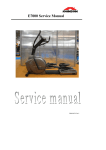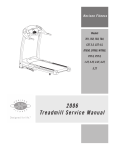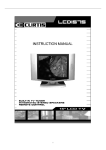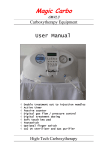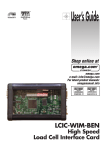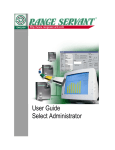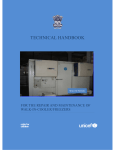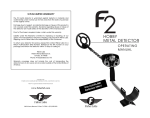Download R7000 Service Manual
Transcript
R7000 Service Manual Revision: 1.0 Date: 2004/7/25 TABLE OF CONTENTS SECTION 1: LIMITED WARRANTY SECTION 2: EXPLODED DIAGRAM SECTION 3: WIRING DIAGRAM SECTION 4: TROUBLE SHLOOTING SECTION 5: PARTS REPLACEMENT SECTION 6: PREVENTIVE MAINTENANCE APPENDIX : RECOMMENDED TOOLS SECTION 1 LIMITED WARRANTY Comments and Questions Scope of Warranty Intended Use Warranty Time Period Defects Replacement Safety Stock of Warranty Parts Defects Return Procedure Technical Support Limited Warranty Johnson Health Technology Company and its employees are committed to providing our customers with the state-of-art designed and manufactured fitness equipment. This Limited Warranty and Service Procedure states JHT’s warranty policy and warranty procedures. C omments aand nd Q uestions Comments Questions We welcome comments and questions regarding our products. Please contact us at Customer Service Johnson Health Technology Company P.O.BOX 22-100 Taichung, Taiwan, R.O.C Telephone: 886-4-25667100 Facsimile: 886-4-25683456 E-mail: [email protected] SScope cope ooff W arranty Warranty All JHT products are warranted against defects in workmanship and materials. Any repairs to the parts itself, especially the electronics parts, will then void the warranty unless the rework is authorized in a written format by JHT in advance. This warranty will also not cover any damage, failure or loss caused by accident, misuse, neglect, abuse, improper assembly, or failure to follow instructions or warning in the owner’s manual. IIntended ntended U se Use JHT products may be warranted for just home use only, all distributors are advised to consult the owner’s manual for the limitations of the application. W arranty PPeriod eriod Warranty Generally, if not otherwise specified, JHT provides one and a half year warranty for all JHT products starting from the date of production. Warranty coverage for each product will be detailed in the respective product owner’s manual. D Deeffeeccttss R Reeppllaacceem meenntt The distributor should send out the replacement parts without charge within 24 hours for any customer’s warranty claim due to defects of JHT workmanship or materials and the defects occurs during the warranty period. The distributor should also send out the replacement with charge within 24 hours for the service claims due to accident, abuse, neglect, or for the claims with the warranty expired. SSaaffeettyy SSttoocckk ooff W Waarrrraannttyy PPaarrttss All the importers and distributors are required to keep an inventory of spare parts especially for those of which are recommended by JHT to service their customers in time. Distributors are advised to purchase the spare parts at 2%~3% of the total value of each shipment along with the shipment order or to always keep in their stock at least 2 to 5 pieces of each spare parts, especially the electronics parts, of the different model. If there is any importer or distributor failed to do so and wish that JHT send the replacement parts by express, it will be within JHT’s discretion how to charge the distributor for both the replacement parts and shipment cost. A list of recommended spare parts could be provided with the shipment sales confirmation as long as the request is made to your JHT sales representative and is contained in the service manual as well. Please refer to the parts list to fill out the Parts Order Form and send it to your sales representative to order the parts as required. W Waarrrraannttyy PPrroocceedduurree Defective electronics: To receive a credit accordingly, the distributor must collect the defective electronics, attach a label or tag on the defective part to identify the following information as a minimum requirements which contain the production serial number, symptom of failure and the warranty claim number. Send the defective electronics back to JHT in a routine basis (monthly is preferred). Fill out the warranty claim form and send it to JHT. Defective motors: The distributor may choose by himself the disposition of the failed motors under warranty. You can either send the motors to your local motor manufacturer’s authorized dealer for repair or you can remove the name plate, attaching a label on it to identify the failure symptom and send it back to JHT on a routine basis (monthly is preferred). Defective Mechanical Components/Accessories: To receive a credit or the free replacement parts for the defective mechanical component under warranty, simply fill out a warranty claim form attached with the photo, graph or other media that could show us the outlook of the failure. Send all the information to JHT for approval. Defect Return: After finishing the above processes with each kind of component, the distributors are then required to contact JHT for a returned authorization and shipping arrangement (This may not be required for the mechanical defects). Once it is authorized by JHT, the distributor should pack the parts in the most appropriate way and send the package by the way as advised by JHT. Issuing Credit: It is within JHT’s discretion to issue a credit or send parts with no charge to the distributors after the returned parts have been verified to be really defective. If the parts returned has been verified to be non defective and is good enough to be used, it will be sent back to the distributor. The distributor will be responsible for all the shipping cost incurred. No credits will be issued on the defective returns that can be proved to fail due to misuse, neglect or abuse. T Teecchhnniiccaall ssuuppppoorrtt If you have any trouble in troubleshooting the failures or if you wish to complain for a mass failure to JHT, you can fill out the Field Failure Report to JHT. JHT will respond to your report within one day. You may call JHT customer service department directly as well if you wish, but before doing this it is preferred for you to send out the forms in advance. SECTION 2 EXPLODED DIAGRAM CONTENTS R7000 EXPLODED DIAGRAM R7000 EXPLODED DIAGRAM SECTION 3 WIRING DIAGRAM CONTENTS CONTROL BOARD WIRING DIAGRAM WIRING DIAGRAM CONTROL BOARD WIRING DIAGRAM ¾ A1 : 3-pin terminal to the generator ¾ A2 : 2-pin terminal to the electromagnet ¾ A3 : 4-pin terminal to the console WIRING DIAGRAM SECTION 4 TROUBLESHOOTING Pedal speed has to be over 30 rpm CONTENTS No display on the console or the display is dim No RPM is displayed during the exercise All or some of the function keys do not response . Feel the resistance increase/decrease or fell no resistance Feel slipping while pedaling Knocking or creaking noise No pulse is displayed on console No pulse is displayed on the console(hand pulse type) Console diagnostics mode No display on the console or the display is dim Possible causes: 1. Console is damaged or the console cable is not connected properly. Fix: 1. First, Check if the adapter is connected properly for both input & output ends . Remove the console, then check if the console cable is connected properly. 2. Poor connection to all the terminals on the control board. 3. Control board is damaged. 4. Generator is damaged. Unplug the console cable and use a multi-meter to check if the voltage on the 1’st and 4’th pin of the console cable is greater than 5 VDC. If it is, replace the console and check again. 2. Open the side covers of the bike and check if all the wire harnesses are connected properly to the terminals of the control board. 3. Unplug the console cable from the control board and check if the voltage on the 1’st and 5’th pin of control board is greater than 5 VDC If it is, replace console cable with a new one. If it is not, next step. 4. Unplug the generator cable from the control board and check if the voltage is variable. If it is, replace the control board with a new one. If it is not, replace the generator with a new one. 註解: No RPM is displayed during the exercise Possible causes: 1. Console cable is damaged or the console cable is not connected properly. Fix: 1. Remove the console and check if the terminal of console cable is connected properly to the console. If it is not connected well. ¾ Connect the terminal properly. ¾ If cable is damaged, replace it with a new one. 2. Console is damaged. 2. Console is damaged, replace it with a new one. 3. Control board is damaged 4. Speed sensor is misaligned(for JPS/E) 3. Open the side covers of the fitness then replaces the control board with a new one. 4. Check if the sensor is misaligned. If it is, place the sensor in the correct position. 5. Poor connection of the sensor. 6. Sensor is damaged(for JPS/E) 5. Open the side covers of the stepper and check if the connection of the sensor is connected properly. If it is not connected well. ¾ Connect the terminal properly. If cable is damaged, replace this with a new one 6. Sensor is damaged, replace it with a new on 註解: All or some of the function keys do not respond Possible causes: 1. Keypad connecting plug has been not fit-in properly. 2. Keypad is damaged. 3. Upper board is damaged. Fix: 1. Remove the console cover, and then check if keypad cable is connected properly to the upper board. If it has not been connected well, reconnect it to the terminal and check again. . 2. Keypad or upper board is damaged. Replace the console Feel the resistance increase/decrease suddenly or feel no resistance Possible causes: Fix: 1. Console is damaged or the console cable is not connected properly 1. Remove the console and check if the console cable has been connected properly. 2. Console cable is damaged, replace it with a new one. 2. Console cable is damaged. 3. Remove the side covers of the fitness and check if the terminal of the control board has been connected properly. Control board is damaged, replace it with a new one. 3. Control board is damaged. 4. Generator is damaged. 4. Generator is damaged, replace with a new one 5. Check if the sensor is positioned correctly. 5. Gap between the electromagnet and the copper disc of the generator is too wide. Re-align the sensor to the correct position 6. Sensor is damaged, replace it with a new one 7. (1)Loosen the assembly screws of electromagnet (2) With a c-vice press the electromagnet to narrow the gap then check again. . Feel slipping while pedaling Possible causes: 1 2 Belt tension is not enough Poly v Belt is damaged Fix: 1 Re-adjust the belt tension. 2 Replace poly v belt with a new one. Knocking or creaking noise Possible causes: 1 2 3 4 Pedal is on crank arm too loose Crank or axle is wear out Belt tension is too loose or poly v belt is too dirty Rail or roller is too dirty Fix: 1 Re-tighten it. 2 Replace it with a new one 3 Re-adjust the belt tension and clean the poly v belt 4 Clean the rail and roller. No pulse display on console (Chest belt type) Possible causes: 1. Chest belt is not placed properly. Procedure: 1. Place the chest belt in the correct position. <Remark 1> 2. Chest belt is damaged. 2. Replace the chest belt with a new one. 3. Console is damaged. 3. Replace the console with a new one. <Remark 1> The correct operation of a Chest Belt. 1. Moisten the electrodes that are located on both ends of the belt. 2. The belt functions will most effective when placed close to the heart and to the skin. No pulse display on the console (Hand pulse type) Possible causes: 1. Connection of hand pulse cable. Procedure: 1. Remove the console to check if the terminal of hand pulse cable has been connected to PCB well. 2. Hand pulse cable is damaged. OR 3. Console is damaged. 2. Replace the hand pulse cable with a new one. OR 3. Replace the console with a new one Console Diagnostics Mode STEP 1 STEP 2 1. Sit (stand) on your bike (stepper), Press and hold down the "RESET” key then (for stepper turn the power on) start pedaling to reach a pedal speed of approximately 30rpm.OR Press and hold down the "RESET” key then plug the adapter (JPE). 2. Dot Matrix Display will be scanned slowly starting from LEDs of the bottom row to the top; each segment of the 7-segments will be scanned simultaneously If one of LEDS is not lit, replace the PCB. STEP 3 1. Press the ENTER key. 2. Dot Matrix Display will be scanned slowly starting from LEDs at the leftmost column to the right. 3. Each 7-segments display will be scanned one by one. If one of LEDS is not lit, replace the PCB. STEP 4 1. Press the ENTER key. 2. Dot Matrix and 7-segments will display lighted up If one of LEDS is not lit, replace the PCB. 1. 2. 3. 4. Press the ENTER key. Dot Matrix Display will show “RPM”. “RPM” window will show current RPM “TIME” window will show total accumulated minutes and seconds. 5. “AGE” window will show total accumulated hour. 6. Hold down the ”RESET” key first then press “PAUSE” key to clear the record. If RPM is not shown, please refer to section 4-2 for troubleshooting. Console Diagnostics Mode SETP 5 STEP 6 STEP 7 STEP 8 1. Press the ENTER key. 2. In the Dot Matrix Display there will be two hearts on it, which will light up completely in turn 3. “STEPS/MINS” windows will show the current heart rate while you are wearing a HAND PULSE SENSOR or POLAR CHEST BELT. If the heart rate is not shown or not stable in the display, please refer to section 4-8 ~ section 4-10 1. Press the ENTER key. 2. Dot Matrix Display will show “D/A”. 3. Press “+/-“ key to increase or decrease resistance. If there is no resistance, please refer to section 4-4~ section 4-5. 1. Press the ENTER key. 2. Dot Matrix Display will show “KEY” on it. 3. Ready for you to enter any key of all 18 keys other than “RESET” now to verify the function of the key.. 4. The RPM window will show you a reference number accordingly while pressing a number or function key. 5. “TIME” window will show you the programming year of the software. 6. “WORK LEVEL” windows will show you the programming month and day. 7. “PULSE “ window will show you the software version. If any of the keys does not work, please refer to section 4-3 1. Press the ENTER key. This completes the procedure. SECTION 5 Spare Parts Replacement Contents GENERAL 5-1 R7000 SECTION 5-1 GENERAL Contents CONSOLE CONSOLE CABLE CONTROL BOARD GENERATOR OR ELECTROMAGNET BRAKE SET CONSOLE REPLACEMENT PROCEDURE 1. Tools required: Philips screwdriver Procedure: 1. Loosen the screws (arrow) from the console using the screwdriver. 2. Disconnect the console cables from the console connectors. 3. Replace the console with a new one and reconnect the console cable to the connector. 4. Tighten the screws that hold the console to the bracket. CONSOLE CABLE REPLACEMENT PROCEDURE Tools required: Procedure: Philips screwdriver 1. Loosen the screws that hold the console to the console holding bracket. Adjustable wrench 2. Unplug the console cable from the console connectors. hex key(8mm) 3. Remove the upper cover, screw crank extractor 4. Remove the crank and side cover coin 5. Disconnect the console cable from the connectors, and then tie the old cable to the new one with a rigid string. 6. Pull the old cable from the top end until the new cable threads all the way through the support. 7. Reconnect the console cables to both the console and control board. 8. Tighten the screws that hold the console to the console bracket. 9. Install the parts. GENERATOR OR ELECTROMAGNET BRAKE SET REPLACEMENT PROCEDURE Tools required: Procedure: 1. Remove all covers. Philips screwdriver Hex key (5mm) Ratchet Box Wrench (11mm) 2. Remove the POLY-V BELT and disconnect the cable from the control board. 3. Loosen the tension screws and screw from the generator (electromagnet brake set.) 4. Replace it with a new one. 5. Secure the tension screw and the screws holding the generator (electromagnet brake set) to the frame (not too tight at this time so that the tension adjustment can be made). 6. Install the POLY V BELT on the front and rear pulley. 7. Use the wrench (11mm) to adjust the belt tension by adjusting the tension screw until you can only press with your thumb the POLY V BELT down about 1~1.5cm, then tighten all the screws. 8. Reconnect the generator (electromagnet brake set) cable to the control board and then install the side covers and the parts. SECTION 5-2 Contents CRANK PEDAL POLY-V BELT 400/380J6 POLY-V BELT 500/440J8 AXLE FRONT PULLEY BALL BEARINGS CRANK REPLACEMENT PROCEDURE Tools required: Crank extractor Procedure: Coin 1 Loosen the crank cover with a coin and remove it. 2 With the crank extractor and open-end wrench loosen the screw attaching the crank to Open-end wrench (14&17mm) the axle. 3 Using the crank extractor and open-end wrench to extract the crank then replace it with a new one. 4 Reverse step 1-3 to install the parts PEDAL REPLACEMENT PROCEDURE Tools required: Open-end wrench(15 mm) Procedure: 1 Using the open-end wrench loosen the screws attaching the pedal to the crank. 2 Replace the pedal with a new one. POLY V BELT400/380J6 REPLACEMENT PROCEDURE Tools required: Philips screw driver Procedure: 1. Remove the crank cover and screw, then remove the crank. Loosen the screws from the side cover with the screwdriver, then remove the footpad, guard and side cover. Hex key (4mm) 2. Loosen the 400 J6 and 500 J8 belts. Crank extractor Coin Open-end wrench (14&17 mm) 3. Loosen the screws from the front pulley by using the hex key (4mm), then remove the front pulley 4. Replace the 400(380) J6 belt with a new one. 5. Tighten the screws from the front pulley by using the hex key (4mm). 6. Install 400(380) J6 and 500(440) J8 belts onto the front and rear pulleys. 7. Install the side covers and the parts. POLY V BELT 500/440 J8 REPLACEMENT PROCEDURE Tools required: Philips screwdriver Hex key (4mm) Open end wrench (14mm) Procedure: 1. Remove the crank cover and screw, then remove the crank. (Refer to section 5-2.1). Loosen the screws from the side cover with the screwdriver, then remove footpad, guard and side cover. Crank extractor Coin Open-end wrench (14&17 mm) 2. Loosen the screws from the front pulley by using the hex key (4mm) and the fit-in screw of idler spring by using screwdriver (The spring replacement is dangerous. Take special cautions during the operation so you will not damage both you and other parts), then remove the front pulley. 3. Remove the 500(440 for JPB-5100) J8 belts from the pulley and replace with the new 500(440)J8 belt 4. Reverse step 1-3 to install the parts. AXLE REPLACEMENT PROCEDURE Tools required: Procedure: 1. Remove the crank cover and screw, then remove the crank. Loosen the screws from the side cover with the Philips screwdriver Hex key (4mm) screwdriver, then remove the footpad, guard and side covers. C-Clip Pliers Wooden hammer 2. Loosen the belts (500/440J8&400/380J6) from the axle Coin Crank extractor Hex key (4mm) Open-end wrench (14&17 mm) 3. With the C-Clip Pliers remove the C-clip. 4. With the wooden hammer tap the axle out 5. Replace the axle with a new one, then install the c-clip by using c-clip pliers. 6. Reverse the step 1-3 to install the parts. PEDAL AXLE-PULLEY ASSEMBLY REPLACEMENT PROCEDURE Tools required: Procedure: Philips screwdriver C-clip pliers Crank extractor Coin Hex key (4mm) Open-end wrench (14&17 mm) 1. Remove the crank cover and screw, then remove the crank. Loosen the screws from the side cover with the screwdriver, then remove footpad, guard and side cover. 2. Loosen the screw (A) and remove it (for the axle-pulley assembly of the new design). 3. Remove the spring attaching the idler pulley to the frame first, then loosen the screws attaching the bearing housing to the axle-pulley assembly using the hex key (4mm) (The spring replacement is dangerous. Take special cautions during the operation so you will not damage both you and other parts, then remove the front pulley) 4. Remove the c-clip (B) by using the c-clip pliers and using the Bearing Puller remove the Bearing Housing PEDAL AXLE-PULLEY ASSEMBLY REPLACEMENT PROCEDURE Tools required: Procedure: Philips screwdriver 5. Remove the c-clip (C) by using the c-clip pliers and remove the metal pulley from the generator using the Bearing Puller. C-clip pliers Crank extractor 6. Remove the c-clip (D) by using the c-clip pliers and remove the idler using the Bearing Puller. Coin Hex key (4mm) Open-end wrench (14&17 mm) 7. Remove the c-clip (B) by using the c-clip pliers and remove the Bearing Housing using the Bearing Puller. 8. Replace the axle-pulley assembly with a new one. 9. Reverse step 1-9 to install the parts. BEARING REPLACEMENT PROCEDURE Tools required: Procedure: Philips screwdriver 1. Loosen the screws from the side covers with the screwdriver then remove crank using pulley (refer to section 5-2.1). Loosen the screws from the side cover with the screwdriver, then remove footpad, guard and side cover. Hex key (4mm) Bearing puller C-Clip pliers Wood-hammer Crank extractor 2. Loosen the POLY-V belts 500/440J8 & 400/380J6 and the fit-in screw of idler spring (The spring replacement is dangerous. Take special cautions during the operation so you will not damage both you and other parts) Coin Open-end wrench (14&17 mm) 3. Using the hex key (4mm) to loosen screws holding the bearing housing to the frame. 4. With the C-Clip Pliers remove the C-clip and then using the Bearing Puller remove the Bearing Housing. If the Ball Bearing failed, replace it. BEARING REPLACEMENT PROCEDURE Tools required: Philips screwdriver Hex key (4mm) Bearing puller C-Clip pliers Wooden hammer Open-end wrench (14&17 mm) Crank extractor Procedure: 5. Remove the C-clip (c) with the C-Clip Pliers and then remove the pulley Assembly by using the Bearing Puller. If the Ball Bearing failed, replace pulley assembly. 6. Remove the C-clip (D) with the C-Clip Pliers and then remove the idler Assembly by using the Bearing Puller then strike bearing out from the housing of idler assembly. Replace bearing with a new one. 7. Reverse step 1-7 to install the parts. SECTION 6 MAINTENANCE PROCEDURE CONTENTS CLEANING THE GROOVES CLEANING THE GROOVES Frequency: Every 3 Procedure: to 4 months. 1 Remove the If there is any dust in the grooves of the Poly-V belts and pulleys, noises will be generated during operation.. Poly-V belts and check the grooves of the belt for dirt or dust and clean it if any. 2 Check the grooves in the pulley for dirt or dust and clean it if any. 3 Check the grooves in the roller pulley for dirt or dust and clean it if any. APPENDIX RECOMMENDED TOOLS A: OPEN-END WRENCH (17mm) B: OPEN-END WRENCH (14mm) A BC D E C: RATCHET BOX WRENCH (11mm) D: E: F: G: PHILIPS SCREWDRIVER SLOTTED SCREWDRIVER CRANK EXTRACTOR MULTIMETER HEX KEYS 1.5, 2, 2.5, 3, 4, 5, 5.5, 6, 8, 10 (mm) F G 1 2 3 4. WOODEN HAMMER BEARING PULLER C-CLIP PLIERS C-CLIP PLIERS 1 2 3 4 APPENDIX









































